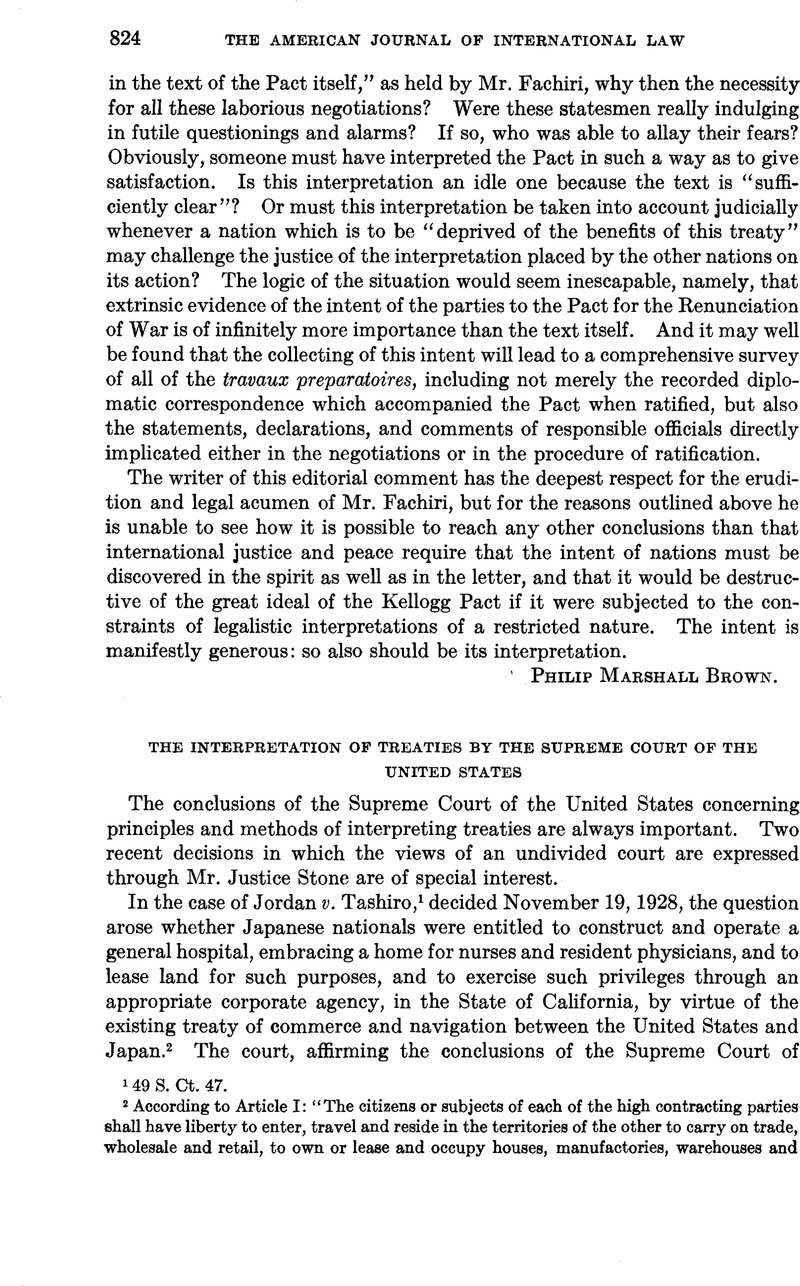No CrossRef data available.
Published online by Cambridge University Press: 04 May 2017

1 49 S. Ct. 47.
2 According to Article I: “ The citizens or subjects of each of the high contracting parties shall have liberty to enter, travel and reside in the territories of the other to carry on trade, wholesale and retail, to own or lease and occupy houses, manufactories, warehouses and shops, to employ agents of their choice, to lease land for residential and commercial purposes, and generally to do anything incident to or necessary for trade upon the same terms as native citizens or subjects, submitting themselves to the laws and regulations there established. . . .”
“ The citizens or subjects of each of the high contracting parties shall receive, in the territories of the other, the most constant protection and security for their persons and property, and shall enjoy in this respect the same rights and privileges as are or may be granted to native citizens or subjects, on their submitting themselves to the conditions imposed upon the native citizens or subjects. . . .”
3 The court cited Geofroy v. Riggs, 133 U. S. 258, 267; Tucker v. Alexandroff, 183 U. S. 424, 437; Wright v. Henkel, 190 U. S. 40, 57; In re Ross, 140 U. S. 453,475; Asakura v. Seattle, 265 U. S. 332. See also Olsson v. Savage, 240 Pac. 586.
4 Terrace v. Thompson, 263 U. S. 197, 223. Webb v. O’Brien, 263 U. S. 313, 323, and Frick v. Webb, 263 U. S. 326, 333, were also cited.
5 There have been times when plenipotentiaries have had no zeal to make clear through the text of a treaty the full scope of sacrifices in fact agreed upon.
6 In the course of the Eleventh Advisory Opinion of The Permanent Court of International Justice concerning the Polish Postal Service in Danzig, it was declared that: “ In the opinion of the court, the rules asto a strict or liberal construction of treaty stipulations can be applied only where ordinary methodsof interpretation have failed.” Publications ofthe Permanent Court of International Justice, Series B, No. 11, p. 39.
7 49 S. Ct. 223.
8 Sections 7315 and 7313, c. 351, Code of Iowa (1927).
9 Article 7 declared that: “The United States and His Danish Majesty mutually agree that no higher or other duties, charges, or taxes of any kind, shall be levied in the territories or dominions of either party, upon any personal property, money, or effects, of their respective citizens or subjects, on the removal of the same from their territories or dominions reciprocally, either upon the inheritance of such property, money or effects, or otherwise, than are or shall be payable in each state, upon the same, when removed by a citizen or subject of such state respectively.”
10 Declared the court: “ The droit de ditraction, referred to in the communication of Mr. Clay of November 7, 1825, and in the note of the Danish Minister of April 14,1826, in which he identified that phrase with the tax prohibited by the additional article of the treaty between Denmark and Great Britain of June 16, 1824, similar in terms to the article now before us, was a survival from medieval European law of a then well-recognized form of tax, imposed with respect to the right of an alien heir to acquire or withdraw from the realm the property inherited. Although often referred to as a tax on property or its withdrawal, the droit de detraction seems rather to have been a form of inheritance tax, but one which, because of its imposition only with respect to property of aliens who normally removed it from the realm, was sometimes associated with the removal rather than the inheritance of the property. . . . Its origin and an examination of the commentators likewise leave no doubt that the droit de detraction–the tax–accrued upon the death of the decedent, and only after it had been collected was the heir entitled to take possession of the property and remove or otherwise dispose of it. It was thus the precursor of the modem inheritance tax, differing from it in its essentials solely in that it was levied only where one ofthe parties to the inheritance was an alien or non-resident.”
11 Compare, for example, Additional Observations, by M. Albert Thomas, of July 20,1922,touching the competence of The International Labor Organization in the matter which became subject of the Second Advisory Opinion, Publications of The Permanent Court of International Justice, Series C, No. 1, pp. 270, 274-281, with Additional Observations by M. de Lapradelle, of July 14, 1922, in the same case, id., 182, 187-189. The oral argument of Sir Douglass Hogg, October 26, 1925, in the case which was the subject of the Twelfth Advisory Opinion, is of interest. Publications of the Permanent Court of International Justice, Series C, No. 10, pp. 18, 20-22.
12 Annex 3 to Judgment No. 16, in case relating to the Territorial Jurisdiction of the International Commission of the River Oder, p. 41.
13 Case of The S. S. Lotus, Publications of The Permanent Court of International Justice, Series A, No. 10, p. 16. It may be observed that the court later declared in the course of its opinion that “ The records of the preparation of the convention respecting conditions of residence and business and jurisdiction would not furnish anything calculated to overrule the construction indicated by the actual terms of Article 15.” Id., p. 17.
14 Fourteenth Advisory Opinion concerning the Jurisdiction of The European Commission of the Danube between Galatz and Braila, Publications of The Permanent Court of International Justice, Series B, No. 4, p. 31. The court saw fit to add: “ Moreover, the records of the preparation of the Definitive Statute do not, in the opinion of the court, fumish anything calculated to overrule the construction indicated by the actual terms of Article 6.